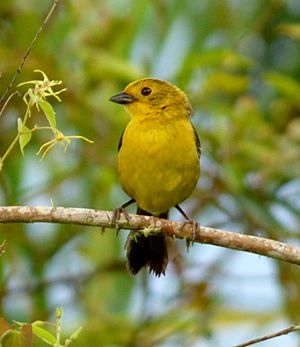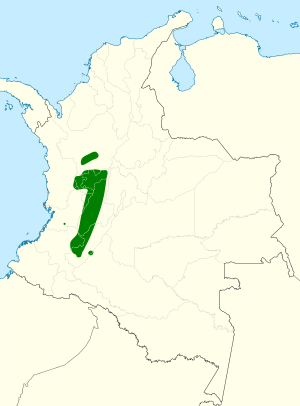Yellow-headed brushfinch facts for kids
Quick facts for kids Yellow-headed brushfinch |
|
|---|---|
 |
|
| Conservation status | |
| Scientific classification | |
| Genus: |
Atlapetes
|
| Species: |
flaviceps
|
 |
|
The yellow-headed brushfinch (Atlapetes flaviceps) is a small bird found only in Colombia. It belongs to the American sparrow family, called Passerellidae. This bird is considered a Near Threatened species, which means it could become endangered if its situation does not improve. Its name, "yellow-headed brushfinch," comes from its scientific name. Atlapetes is the name of its bird genus, and flaviceps means "yellow-headed" in Latin.
This bird has a head that can be yellow or a dark olive color. Its throat, chin, and the areas around its eyes and ears are usually bright yellow. The rest of its body is mostly yellow with dark olive colors on its back, wings, and tail. Scientists think that the birds with more olive-colored heads might be females or younger birds.
Contents
Why is it called the Yellow-Headed Brushfinch?
This bird was once called the olive-headed brushfinch. This name came from a mistake! The yellow-headed brushfinch lives in a very small area and is quite rare. For many years, only a few bird experts knew about it. They had only seen a few dead birds collected in 1911 and 1942. These birds had bright yellow heads.
Then, in 1987, the first photo of a living yellow-headed brushfinch was published. This photo showed a bird with very little yellow on its head. It looked like its head was mostly a dull olive color. This picture was shared widely in a popular field guide. Because of this photo, the misleading name "olive-headed brushfinch" became very popular.
In 1989, scientists found the bird again in the same place where the first ones were collected. They saw that some birds had the olive-colored heads, just like in the photo. But they also saw that adult male birds had the bright yellow heads that were first described. Because of this, a group called BirdLife International decided in 1992 that "yellow-headed brushfinch" was the best name. The American Ornithologists' Union later agreed.
Where the Yellow-Headed Brushfinch Lives
This bird lives only in Colombia. Most recent sightings have been in the upper Coello River area in the Tolima Department. You can find it between 1,000 and 2,500 meters (about 3,300 to 8,200 feet) above sea level. It lives in places like Cajamarca, Ibagué, and Roncesvalles. It might also live in Rovira. These areas are near the Anaime, Cocora, Combeima, and Toché river valleys.
The yellow-headed brushfinch is still common in certain spots. It likes areas with thick, new plant growth and forests that have been partly changed by humans. It also lives near gallery forests and farms that grow arracacha (a root vegetable) and granadilla (a type of passion fruit).
Bird Behavior and Threats
These birds sometimes join mixed-species feeding flocks. This means they fly and search for food with other types of birds. Some of the birds they feed with include the common bush-tanager, white-throated tyrannulet, golden-fronted whitestart, blue-and-black tanager, blue-capped tanager, and fawn-breasted tanager.
The biggest threat to the yellow-headed brushfinch is habitat loss. Many areas in the valleys of the Andean mountains in Colombia have been turned into farmland. This means the birds lose their homes. Scientists believe there are at least 250, but no more than 1,000, adult yellow-headed brushfinches left in the wild.
See also
 In Spanish: Atlapetes cabecigualdo para niños
In Spanish: Atlapetes cabecigualdo para niños


